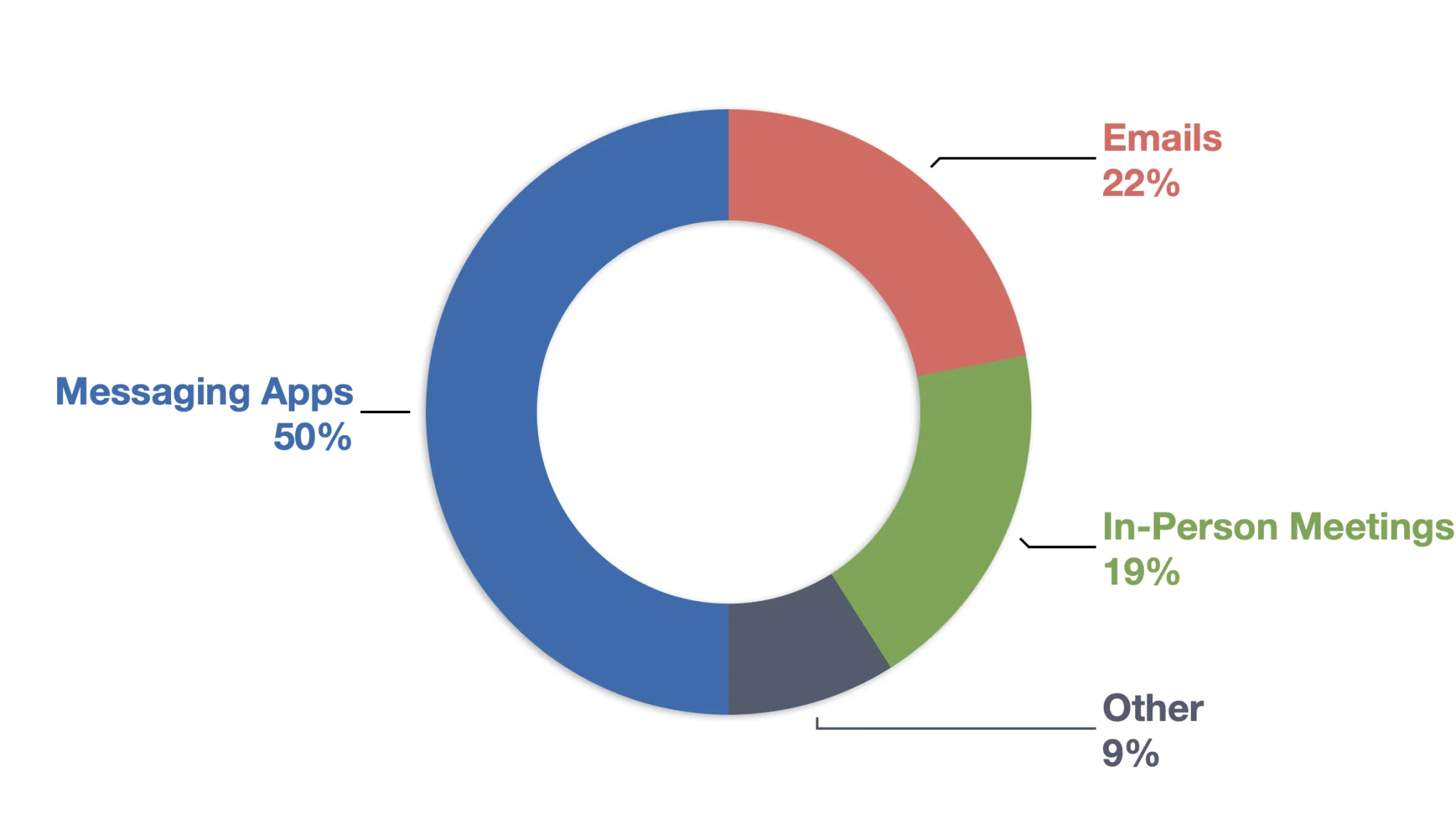Remote work is no longer just a trend.
It has transformed into a cornerstone of modern business practices, embraced increasingly across the globe.
The shift from traditional office settings to more flexible, home-based environments has gained momentum, especially after the unprecedented push from recent global events.
Small business owners, in particular, stand at a crossroad.
For them, understanding the trajectory of remote work is not just beneficial; it’s imperative.
The importance of this shift cannot be overstated.
 Key Takeaways
Key Takeaways
- Embrace Remote Work as a Long-term Strategy Integrating remote work can significantly reduce costs and enhance operational flexibility.
- Invest in Remote Infrastructure Equip your team with the necessary tools and technologies to boost productivity and ensure seamless remote operations.
- Develop Clear Remote Policies Establish guidelines that promote productivity and well-being to support a healthy work-life balance and clear performance expectations.
- Foster Company Culture Remotely Implement strategies to maintain team cohesion and culture through regular interactions and digital tools that encourage collaboration.
- Prepare for Future Trends Stay informed and adaptable to leverage advancements in remote work technologies and evolving work patterns.
As business landscapes evolve, the ability to adapt becomes a key determinant of success.
For small businesses, this means rethinking strategies and tools to stay competitive and resilient.
The objective of this article is clear: to arm small business owners with vital statistics and insights.
These will illuminate the path of remote work and help these entrepreneurs harness its full potential.
Let’s dive in and explore what the future holds, ensuring small business owners are not just participants but pioneers in the remote work revolution.
 Table of Contents
Table of Contents
The Current State of Remote Work: Key Statistics and Trends

Remote Work Adoption Statistics 2025: Current Prevalence
Remote work’s surge in popularity is redefining the modern workplace, notably within the small business sector, which is increasingly embracing this flexible model.
The latest remote working stats from various studies highlight the evolving landscape, with remote business owner insights revealing significant shifts in how companies operate and adapt to new workforce models.
A 2023 report revealed that a significant 82% of remote workers prefer working from their homes, up from previous years, indicating a solid preference for home-based offices (Source).
Additionally, 64% of workers now have fully remote roles, and a notable 71% express a preference for this arrangement, emphasizing the strong demand for remote work options (Source).
The growth of remote work is also reflected in long-term desires, with 98% of employees stating they would like the option to work remotely for the rest of their careers, showcasing the enduring appeal of this work style (Source).
Despite these preferences, 94% of workers admit they could be persuaded to return to the office, suggesting that while remote work is preferred, flexible options could bridge the best of both worlds (Source).
In terms of adoption rates, from 2017 to 2018, around 34.7 million U.S. full-time workers had the option to work from home, demonstrating the growing acceptance of remote work pre-pandemic (Source).
By May 2020, in response to the pandemic, this number skyrocketed, with an additional 48.7 million U.S. employees working from home, highlighting the scalability and rapid deployment of remote work capabilities during crises (Source).
Post-pandemic remote work statistics 2022 show a settled pattern, with 22% of employees working exclusively from home and 17% in a hybrid setup, indicating a stabilization of remote workforce trends (Source).
If unable to work remotely, 29% of hybrid and remote workers would expect a salary increase to cover the additional costs incurred by commuting and other expenses, suggesting that remote work offers significant financial benefits to employees (Source).
The permanent adoption of remote work is also on the rise, with 71% of companies allowing some degree of remote work as a fixture of their operational strategies, underlining the shift towards more adaptable work environments (Source).
These remote worker statistics collectively show that remote work is not just a temporary adaptation but a fundamental shift in how companies, especially small businesses, plan their future workforce strategies. The data reveals significant remote work growth across all business sectors.
The broad acceptance and preference for remote work are shaping a new corporate culture that prioritizes flexibility, employee satisfaction, and operational efficiency.
Remote Work Benefits and Challenges 2025: Advantages for Small Businesses

Remote work brings a multitude of benefits to small businesses, emphasizing why it’s becoming a core strategy in their operations.
Firstly, remote work significantly cuts costs.
It eliminates the need for large physical office spaces, thus reducing rent, utilities, and maintenance expenses.
These savings can be substantial, allowing small businesses to allocate funds to other critical areas such as product development, marketing, or scaling operations.
Productivity gains are another major benefit.
Many small businesses report that their employees are more productive when working remotely, largely due to fewer in-office distractions and a more personalized work environment.
This productivity boost is essential for small businesses that need to maximize resources and outputs.
Expanding the talent pool is perhaps one of the most strategic advantages of remote work.
Small businesses are no longer constrained by geographic limitations and can attract talent from anywhere in the world. This approach demonstrates how small e-commerce businesses can expand using remote workers to access global talent pools and scale operations efficiently.
This wider talent pool leads to more diverse teams and brings in skills that might not be available locally.
Moreover, remote work significantly enhances employee retention and satisfaction.
Employees value the flexibility that remote work offers, contributing to a better work-life balance.
This not only helps in retaining talent but also attracts new employees who prioritize flexibility in their work environment.
As small businesses adapt to the shifting paradigms of the workplace, remote work emerges as a key element in their strategy.
It not only aligns with broader business trends but also provides tangible benefits that can help small businesses stay competitive and resilient in a rapidly changing world.
The Future of Remote Work

Technological Advancements Facilitating Remote Work
The future of remote work 2023 and beyond hinges significantly on technological advancements that are reshaping distributed workforce statistics.
Collaboration tools, cloud computing, and immersive technologies like virtual and augmented reality are at the forefront, driving the way work happens outside traditional offices.
Collaboration tools have become the backbone of remote work.
In 2019, tools such as video-call software like Teams, Webex, and Zoom, alongside cloud file-sharing platforms like Box, Drive, and Dropbox, already facilitated remote workflows effectively (Source).
Since then, their usage has only expanded.
Microsoft Teams, for instance, saw its daily users skyrocket to 270 million by 2022, up from just two million in 2017, reflecting the massive uptick in demand for collaboration platforms (Source).
However, challenges remain.
Despite the critical role of these technologies, only 37% of employers upgraded their video meeting technology in 2023, which might contribute to the 80% of workers experiencing lost time due to technical difficulties in online or hybrid meetings (Source).
This underscores a gap that still exists in optimal technology deployment and user experience.
Looking ahead, generative AI is a game-changer.
Approximately 44% of workers anticipate that AI will help them perform their jobs faster and more effectively over the next five years (Source).
This expectation mirrors the broader tech landscape, where U.S. patent applications mentioning remote work-related terms tripled post-pandemic, signaling a surge in innovations tailored for remote settings (Source).
Remote collaboration trends further show that 50% of interactions occur via messaging apps, followed by emails (22%), and meetings (19%), indicating that real-time, less formal communication prevails (Source).

Moreover, 62% of remote workers prefer to be on camera during video calls, suggesting that visual interaction remains a key component of remote communication dynamics (Source).
The Impact of COVID-19 on Remote Work

The COVID-19 pandemic catalyzed an unprecedented acceleration in remote work adoption.
The above chart illustrates the percentage of employees with access to remote work options before the COVID-19 pandemic in the U.S. in 2019. The data highlights increased remote work access in larger companies. Courtesy: Statista
At the height of the pandemic in May 2020, over 60% of workdays were spent at home due to social distancing and infection risks, fundamentally changing remote work statistics 2020.
By the summer of 2023, this settled to about 25% of days being worked from home, a significant increase from about 5% in 2019 (Source).
This seismic shift had lasting effects.
For instance, 54% of workers now believe that business travel in their organizations has returned to pre-pandemic levels, illustrating a rebound in certain pre-COVID work practices (Source).
However, the legacy of the pandemic on work structures is indelible, with a marked increase in the share of workdays conducted remotely, solidifying a long-term trend toward decentralized workplaces.
Small businesses, in particular, learned critical lessons during the pandemic.
They discovered the value of agility and the importance of having robust digital infrastructures that can support sudden shifts in work modalities.
This period was a steep learning curve, but also a demonstration of the resilience and adaptability that will define the future of work.
Looking forward, the trajectory of remote work continues to evolve.
As businesses and technologies adapt, the workplace of tomorrow will likely be more flexible, more digital, and more responsive to the needs of a diverse and dispersed workforce.
The ongoing innovations and experiences will shape a new era where remote work is not just an emergency measure but a standard mode of operation.
The Challenges of Remote Work for Small Business Owners

Maintaining Company Culture and Team Cohesion
One of the most significant challenges for small business owners in a remote environment is preserving company culture and fostering team cohesion. Understanding these trends unresolved problems remote work small business needs helps companies develop more effective remote work strategies.
When teams work remotely, they often miss out on the spontaneous interactions that contribute to team bonding and a cohesive culture.
In fact, 68% of managers believe that their hybrid or remote employees miss critical impromptu or informal feedback, which can be vital for development and morale (Source).
Communication breakdowns and the barriers to mentoring can also reduce productivity and harm the cultural fabric of an organization.
These issues are notably prevalent in fully remote setups, where traditional office dynamics are absent (Source).
Despite these challenges, 75% of remote workers still feel connected to their colleagues, suggesting that with the right tools and strategies, maintaining a strong company culture is achievable (Source).
Advancements in virtual collaboration tools and efforts to digitize office culture are making it possible for remote work to be sustainable in the long term.
These technologies and initiatives help replicate an office-like environment online, enabling more natural interactions and a sense of belonging among team members (Source).
Ensuring Data Security and Compliance
Data security and compliance represent critical concerns for remote work settings.
The dispersed nature of remote teams can increase the risks of data breaches and complicate compliance with regulations.
Addressing these risks requires robust security protocols and regular training on data protection practices.
Managing Employee Performance and Well-being
Managing employee performance and well-being remotely requires careful strategy and thoughtful leadership.
Tracking performance can be challenging without the direct observation possible in an office setting.
Furthermore, 56% of workers have reported an increase in work-related stress over the past year, underscoring the need for supportive measures to manage stress and promote well-being (Source).
Remote work can also lead to a 10% drop in productivity compared to in-person settings, largely due to communication issues and challenges in self-motivation (Source).
Yet, 44% of remote workers report working more this year than last, suggesting a shift towards longer working hours (Source).
Burnout is another significant issue, with 20% of remote workers feeling more burnt out than they did a year ago.
This highlights the importance of establishing clear boundaries and supporting work-life balance (Source).
Despite these challenges, 58% of remote workers feel engaged with their jobs, and 81% check work emails outside of work hours, showing high levels of commitment and engagement (Source).
Interestingly, perceptions of productivity vary by generation.
While only 23% of Generation Z workers feel as productive remotely as they do in the office, 65% of Baby Boomers report no change in productivity when working from home, indicating generational differences in adapting to remote work (Source).
As you can see, small business owners face multiple challenges in managing remote teams, from maintaining culture and cohesion to ensuring data security and managing well-being.
Addressing these issues effectively requires a blend of technology, flexible policies, and a focus on communication and support.
With these strategies in place, businesses can overcome the hurdles of remote work and harness its many benefits.
Preparing for the Future of Remote Work

Adapting Business Models and Strategies
As the landscape of work continues to evolve, small business owners must consider remote work not just as a temporary adjustment but as a pivotal component of their long-term remote work strategies.
Reevaluating and adapting business processes to support remote work is crucial for sustainability and growth.
One noticeable trend among hybrid employees is the practice of “coffee badging,” where 58% of workers show face at the office before quickly departing.
This behavior highlights the superficial need to appear present and raises questions about traditional work expectations that 69% of respondents feel companies still hold on to (Source).
Job stability varies among work environments.
In 2023, 23% of employees switched companies, with a higher turnover among full-time office workers (26%) compared to those in hybrid or remote settings (17%) (Source).
This suggests that remote and hybrid models might be more effective in retaining staff, supported by findings that hybrid working does not affect productivity and enhances recruitment and retention efforts (Source).
Interestingly, as companies transition back to on-site work, more than half have planned to implement permanent remote options for appropriate roles, indicating a blend of traditional and modern work setups is becoming standard (Source).
This hybrid model resonates with nearly 50% of workers who prefer to split their time between home and the office post-pandemic (Source).
Investing in Remote Work Infrastructure
To ensure success in remote work, investing in the right infrastructure is essential.
This includes not only the necessary technology but also supporting employee training and development to optimize remote operations.
The pandemic spurred increased investment in technologies that support remote work, with 64% of companies now paying for hardware items needed for remote work and 40% covering costs for office equipment like desks and chairs. These remote work cost savings statistics 2025 show how businesses are adapting their investment strategies while maintaining operational efficiency.
Moreover, 28% of remote workers report that their company pays for their home internet, reflecting a commitment to equipping staff with the tools they need to succeed remotely (Source).
Developing Remote Work Policies and Guidelines
Developing clear and effective remote work policies is critical.
These policies should not only promote productivity but also support employee well-being by establishing work-life boundaries.
Remote work policies are evolving, with indications that some fully remote jobs may decline in the longer term due to potential overseas relocation or automation.
Yet, 22% of remote workers find it difficult to unplug from work, pointing to a need for more defined boundaries and guidelines (Source), (Source).
Employers also report that the majority of employees favor working from home, which underscores the popularity of remote work setups and the importance of crafting policies that reflect employee preferences and operational requirements (Source).
By addressing these aspects—adapting business models, investing in infrastructure, and developing thoughtful policies—small business owners can effectively prepare for a future where remote work plays a central role in their operations.
This preparation will not only cater to current employee needs but also position these businesses as forward-thinking and adaptable in a rapidly changing work environment.
In Summary…
The future of remote work offers both promising opportunities and notable challenges for small business owners.
Understanding and embracing this model is not merely about keeping pace with trends but about actively enhancing business resilience and operational efficiency.
This article has highlighted key aspects, including the adaptation of business models, investment in robust infrastructure, and the development of comprehensive remote work policies.
Lessons Learned
1. Adapting Business Models:
The move towards remote work necessitates a reevaluation of current processes and workflows.
This adaptation allows businesses to remain flexible and responsive to market changes and employee needs.
2. Investing in Infrastructure:
Ensuring employees have the necessary tools and technologies is crucial.
This investment supports productivity and helps maintain business continuity, no matter where your team is located.
3. Developing Policies:
Clear remote work policies promote a healthy work-life balance and set expectations that guide employee performance and engagement.
By integrating the strategies discussed, small business owners can leverage remote work to cut costs, access a broader talent pool, and increase employee satisfaction and retention. These remote work productivity benefits statistics demonstrate the value of implementing comprehensive remote work business models.
The practical application of these insights helps create a work environment that is adaptable and prepared for future disruptions or changes in the work landscape.
Embracing remote work is not just about technology; it’s about fostering a culture that supports flexibility and innovation.
This approach can lead to improved productivity and a more resilient business model that can weather the challenges of tomorrow. Understanding work from home statistics 2025 and the percentage of employees working from home helps businesses prepare for continued remote work adoption.
Don’t let the future of work pass you by.
Prepare your business today by embracing the strategies outlined in this article.
Schedule a consultation call with Business Initiative to explore how we can help you adapt and thrive in a remote work environment.
Alternatively, you can reach out through our contact form to get started.
Stay informed on the latest trends and insights by subscribing to The Initiative Newsletter, and follow us on X (Twitter) for real-time updates and expert advice.
Take the step today to future-proof your business.
Embrace the change, and let us help you navigate the complexities of remote work with confidence and strategic foresight.
FAQs - Frequently Asked Questions About Remote Work

What is the current state of remote work?
Remote work is widespread, with most employees preferring to work from home.
The pandemic accelerated remote work adoption, making it a standard practice.
Learn More...
The current state of remote work shows significant growth, with 64% of workers in fully remote roles.
A 2023 report by Buffer revealed that 82% of remote employees prefer working from home, indicating a strong preference for remote work.
In 2020, the pandemic drove rapid adoption, with over 48 million U.S. workers shifting to remote work, creating lasting changes.
Post-pandemic, 22% of employees work exclusively from home, while 17% follow a hybrid setup, reflecting a stabilized pattern.
The permanent adoption of remote work is rising, with 71% of companies allowing some degree of remote work as a key operational strategy.
What benefits does remote work offer small businesses?
Remote work reduces costs and increases productivity for small businesses.
It enables access to a wider talent pool and improves employee satisfaction.
Learn More...
Remote work eliminates the need for large physical office spaces, reducing rent, utilities, and maintenance expenses.
Productivity gains are achieved through fewer in-office distractions and more personalized work environments.
Remote work expands the talent pool, allowing small businesses to attract skilled workers from anywhere, enhancing team diversity.
The flexibility of remote work improves employee retention and satisfaction by offering a better work-life balance.
How does technology shape the future of remote work?
Technological advancements like collaboration tools and AI are driving the future of remote work.
Innovations in cloud computing and virtual reality make remote collaboration more efficient.
Learn More...
Collaboration tools like Microsoft Teams and Zoom have become the backbone of remote work, facilitating global workflows.
Microsoft Teams saw its daily users skyrocket to 270 million by 2022, up from two million in 2017, reflecting the demand for these platforms.
Generative AI is a game-changer, with 44% of workers believing it will help them perform their jobs faster and more effectively over the next five years.
Remote collaboration trends show that 50% of interactions occur via messaging apps, followed by emails (22%) and meetings (19%).
How did the COVID-19 pandemic impact remote work?
The COVID-19 pandemic accelerated remote work adoption, causing a permanent shift.
It led to over 60% of workdays being spent at home in May 2020.
Learn More...
In May 2020, over 60% of workdays were spent at home due to social distancing and infection risks, which accelerated remote work adoption.
By the summer of 2023, 25% of days were still being worked from home, a significant increase from 5% in 2019, indicating a long-term trend.
Small businesses learned valuable lessons about agility and digital infrastructure, adapting to sudden shifts in work modalities.
The pandemic solidified a lasting trend toward decentralized workplaces, with remote work becoming a standard mode of operation.
What challenges do small business owners face in remote work?
Maintaining company culture, managing performance, and ensuring data security are key challenges.
Addressing these requires technology, flexible policies, and strategic communication.
Learn More...
Maintaining company culture and team cohesion is difficult without spontaneous office interactions, as 68% of managers believe their teams miss informal feedback.
Data security and compliance risks increase with remote teams, requiring robust security protocols and training.
Managing employee performance is challenging without direct observation, with 56% of workers reporting increased work-related stress.
Burnout is a significant issue, with 20% of remote workers feeling more burnt out than a year ago, highlighting the need for work-life balance.
Despite challenges, 58% of remote workers feel engaged, and 81% check work emails outside of work hours, indicating high commitment.


